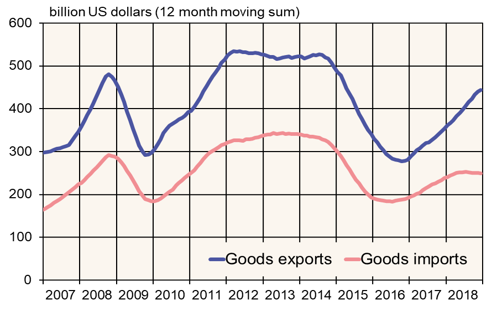BOFIT Viikkokatsaus / BOFIT Weekly Review 2019/07
Russian customs reports that in 2018 the country’s goods trade surplus climbed to 212 billion dollars, or roughly 12 % of GDP.
Russian goods exports rose by 26 % from previous year. This reflects changes in both quantities and prices. Some of these may prove to be temporary. Energy prices are a major driver of fluctuations in Russia’s case.
The EU accounted for 46 % of Russian exports, while 12 % went to China. Two-thirds of earnings from goods exports came from fossil fuels. The combination of a slight increase in oil and gas export volumes and higher world prices raised export earnings by a third. In addition to fossil fuels, there were also significant increases in exports of metals and grains. With the bumper crop of autumn 2017, 2018 wheat exports were up by a third from 2017. Russia produces about 10 % of the world’s wheat. In recent years, about half of Russia’s wheat production has gone to exports.
The trend in exports last year was not reflected in imports. Russians spent only 5 % more on imported goods in 2018 than in the previous year. Import growth was depressed by ruble depreciation of more than 10 % against the dollar and euro.
About 37 % of Russia’s goods imports last year came from the EU and 22 % from China. While half of imports consisted of machinery, equipment and vehicles, growth in the category was modest. Pharmaceuticals and foodstuffs were also important import good categories.
Value of Russian goods exports and imports

Source: Federal Customs Service of Russia.